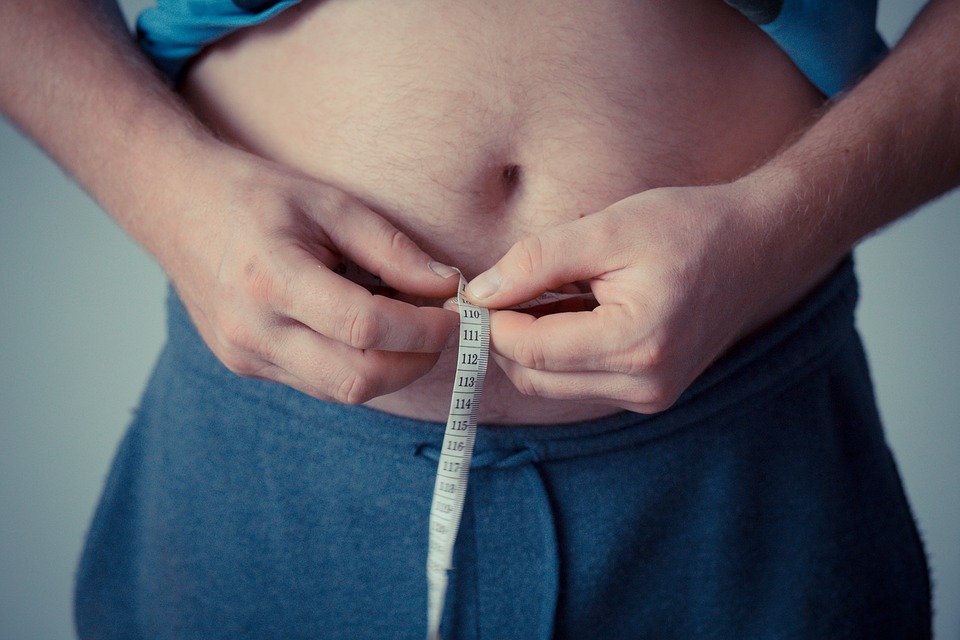People generally do the opposite of what they should be doing when they want to lose more fat:
- They slash their calories
- They crush themselves on spin bikes and in group exercise classes
- They use caffeine to “cover up” crappy sleep habits
- They diet for months on end
- They do ultra high rep workouts and barely rest between sets
- They add tons of stressors (ex. intense diets and exercise) to an already stressful life
While while-intentioned… these “strategies” offer very little bang for your buck and set you up to yo-yo diet.
There are nine more effective ways to boost your metabolism and lose more fat — and you’re about to learn all nine. But first:
What is your metabolism?
Your metabolism is the chemical reactions that change food into energy. Your metabolic rate refers to the speed of these processes. Somebody with a higher metabolic rate burns more calories on a daily and weekly basis.
Which is exactly what we’re going to discuss how to do today.
But it’s crucial for us to understand how our body burns calories on a daily basis first. This is what’s called your “TDEE”: total daily energy expenditure. A person with a high TDEE has an easier time entering a calorie deficit: where you burn more calories than you take in. This is how all diets produce weight loss (no matter how they’re marketed).
Here’s what makes up your TDEE:
- Your basal metabolic rate (“BMR”). This is how much energy your body needs to accomplish its most basic functions (ex. breathing and circulating blood) in a rested state. Your BMR makes up the biggest chunk of your TDEE (60-75%), and is impacted by several factors outside of your control — like your age, gender, and genetics
- Non-exercise activity thermogenesis (“NEAT”). This is a fancy way of referring to non-gym activity. It can be both conscious (going on a walk) or subconscious (fidgeting at your desk) — and makes up ~15% of your TDEE. People who seem to have an easy stay time staying lean often have very high levels of “subconscious” NEAT
- The thermic effect of food (“TEF”). This is how many calories you burn digesting your food. It makes up ~5-10% of your TDEE (slightly more if you eat enough protein)
- Exercise activity thermogenesis (“EAT”). This is how many calories you burn exercising. It’s not nearly as much as your Apple Watch or Fitbit leads you to believe — but still accounts for 5-10% of your TDEE
Here’s a popular visual:

Photo via Research Gate
“REE” stands for your “resting energy expenditure.” This is how many calories you burn at complete rest. “NREE” stands for the opposite: non-resting energy expenditure. This is how many calories you burn when you’re moving your body or eating.
What do I do with this information?
Let’s start with what not to do with this information:
- Blame your age or genetics for your lack for progress (this gives up your power)
- Agonize over which factors are outside of your control
- Quit your job to walk all day
- Go on a protein powder-only diet
- Run yourself into the ground with intense workouts or cut your calories to “make up for” your low TDEE
You’re much better off focusing on the nine most effective ways to boost your metabolism and lose more fat:
Strategy #1: Eat as much as possible
Your metabolism “adapts” every time you cut your calories and lose weight. This is inevitable and not anything to panic about. But crash dieting reduces your metabolic rate much more — both in the short and long-term. This is highly avoidable if you eat as much as possible while still losing weight at a healthy rate: ~.5-1 pound(s) per week.
Some other benefits of going this route (instead of crash dieting):
- More energy throughout the day
- Better workouts and recovery between them
- More flexibility to enjoy splurges
- An easier path to a better relationship with food
- A more sustainable process
Think about it: when was the last time you ate like a bird and saw permanent results from it?
Strategy #2: Eat more protein
We already know that the “thermic effect of food” (TEF) is how many calories you burn digesting your food. But every macronutrient has a different thermic rate:
- Protein: 20-30% of its calories burned during digestion
- Carbs: 5-10% of its calories burned during digestion
- Fat: 3-5% of its calories burned during digestion
To put this into perspective:
- Only 70-80 out of every 100 calories of protein is absorbed by the body
- 90-95 out of every 100 calories of carbs is absorbed by the body
- 95-97 out of every 100 calories of fats is absorbed by the body
This doesn’t mean carbs or fats are “bad,” and that you need to scarf down nothing but chicken smoothies in order to lose fat (yes, that’s a thing). But there is upside to getting .8+ grams of protein per pound of bodyweight:
- You’ll burn more calories digesting your food
- Protein is more filling than any other macronutrient
- It supports muscular retention and development (hugely important for looking “toned”)
- It’s next to impossible to store as body fat (even in large amounts). Meaning you can keep more food on your plate and still lose fat
If consistently getting 120-160+ grams per day sounds like a ton to you… you can request a free copy of the One-Stop Nutrition Guide — my single most popular guide on easily boosting your intake:
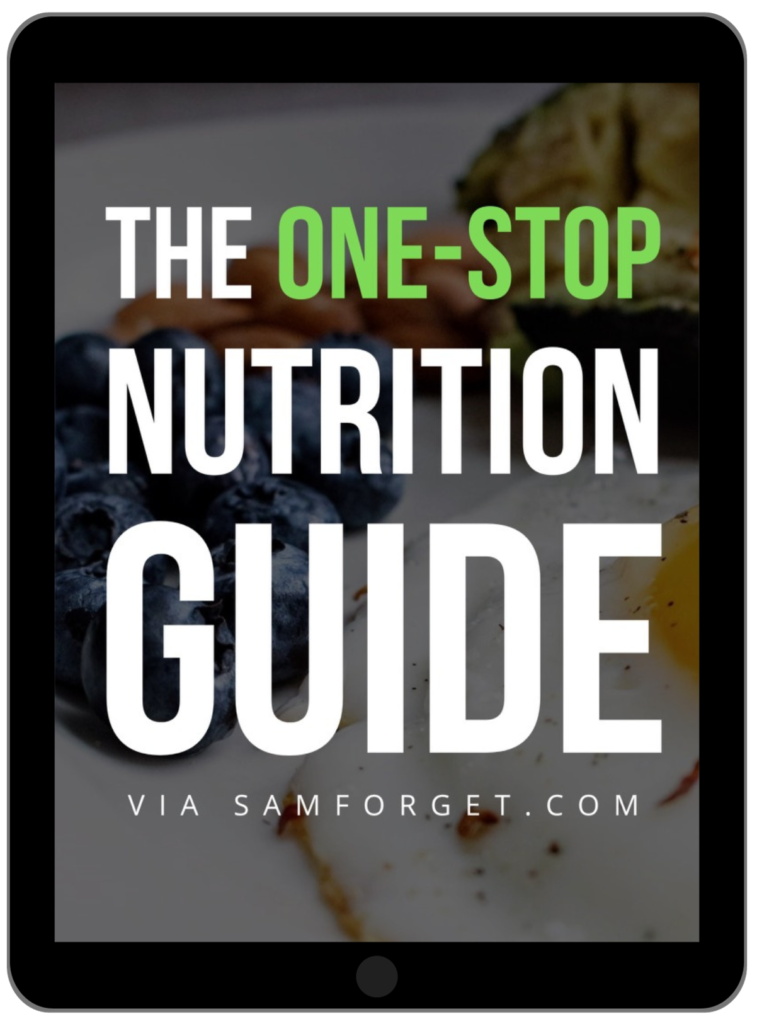
Just tell me where to send your copy:
Strategy #3: Eat more fiber
A high fiber intake supports metabolism and fat loss in a variety of ways:
- Fiber is extremely filling — leading you to feel satisfied with fewer calories
- High fiber foods are often low in “calories per bite.” This means you can have a lot of them on your plate without exceeding your calorie range
- The body doesn’t digest fiber well, and its calories are passed without being absorbed. This is why some people only count their “net” carbs — but I don’t recommend going this route. It’s an unnecessary step and typically backfires
- The body absorbs fewer calories from your meals while digesting fiber
- Fiber supports good digestive health, which impacts everything from how you feel to how you utilize nutrients
I compiled 20+ of the best high fiber foods right here.
How much fiber is enough?
I generally recommend ~14 grams of fiber for every 1,000 calories you’re eating (less if you’re over 50). For most people I work with, this is 20-33 grams per day (well over the 10-15 grams most people get).
If you’ve never tracked this before, or feel like it’s a lot when you do, read this in-depth guide on planning a full day of eating for weight loss goals.
Strategy #4: Drink more water
“Craving pizza? Drink ice water instead!”
Not very helpful advice, is it?
Contrary to popular opinion, water isn’t a one-size-fits-all solution to every food problem. In fact, if you’re chugging a gallon of water per day to “stop yourself” from splurging, that’s a separate issue to address. But staying well-hydrated can:
- Keep your energy up when your calories are lower — making it more enjoyable to walk and exercise
- Keep you reasonably satisfied between meals (in conjunction with a well-rounded diet)
- Support a healthy metabolism
Think of it like icing on the cake. It’s not going to make you lose 20 pounds overnight — but there’s only upside to drinking 50+% of your bodyweight in ounces (ex. 100 ounces if you weigh 200 pounds).
Strategy #5: Walk more… a LOT more
If you don’t get 6,000-8,000+ steps per day, quickly getting to this range will produce noticeable results. As you saw in the chart above, much of our TDEE is based on factors outside of our control. But NEAT (non-exercise activity) is very much within our control, and offers a laundry list of benefits:
- A higher TDEE
- More energy throughout the day
- Better sleep (especially if you walk outside)
- Reduced blood pressure
- Lower stress
- Better bone density
- Improved cardiovascular health
- Reduced blood sugar
- Better recovery between workouts
If you already get 6,000-8,000+ steps per day, aim for 10,000+ — and don’t count your workouts toward this total. When your non-exercise activity reaches this level,* you’ll see a big difference in not only how you look, but how you feel on a daily basis.
Keeping in mind: 3-5 hours of exercise is only ~2% of the week. You can’t consider yourself “active” if you’re not moving your body very much outside of your workouts.
*Most people move less the longer they diet (without actively choosing to). This is because the body is good at conserving energy in an effort to maintain homeostasis. So you need to make a conscious effort to remain active if you want to keep your TDEE high.

Strategy #6: Work out less
Most people make the mistake of thinking crazy hard workouts are the best way to boost your TDEE. This simply isn’t true. Here’s why:
- Exercise makes up a surprisingly small percentage of your TDEE (unless you happen to be Michael Phelps)
- Exercise doesn’t burn nearly the calories your Apple Watch or Fitbit says it does
- Your body adapts to the activities you do often — meaning you eventually burn fewer calories doing them
- Most people are ravenous after grueling workouts (especially cardio-based ones) — making it harder to stick to a reduced calorie range
- Dieting in itself is a stressor. Adding even more stressors (in the form of hard and frequent workouts) to your life hinders progress more than helping it
- It’s not always practical to exercise more. Especially if you have a lot of responsibilities at work or at home
This isn’t to say you shouldn’t exercise 3-4 days per week. But you’ll quickly reach a point of diminishing returns beyond this (especially if your sleep, stress, and nutrition aren’t dialed in).
Strategy #7: Prioritize strength training and muscle gain
I hate to break it to you, but Peloton and group exercise classes don’t cut it here. When I say “strength train,” I’m talking:
- 5-6 exercises per workout
- 10-14 hard sets per workout
- Several sets between 6-12 reps
- Legitimate rest periods (1-3+ minutes)
- Compound exercises (like Presses, Rows, Squats, and RDLs)
- Minimal variety over 6-8+ weeks
If this doesn’t feel like enough, you’re not pushing hard yourself enough. As a general rule of thumb, you should only have ~2 reps “in the tank” at the end of each set. If you know you could’ve done more, you need to add more weight.
Over time, this will allow you to put on muscle, which is slightly more “metabolically active” than fat. In other words, you burn more calories at rest when you have more of it.
But honestly, the metabolic differences are subtle. The real difference-maker is how your body changes when you make strength training and muscle gain a priority. Whether your goal is being more “toned,” lean, muscular, or jacked, you’ll be very happy with the result.

My longtime client Caitlin is a great example of what can happen when you prioritize getting stronger over time
Strategy #8: Reduce your stressors
I can’t sit here and give you a “quick tip” for being completely Zen 24/7. But I can remind you that both diet and exercise are stressors — and you’ll only worsen your results if you turn up these dials without making an effort to turn down other ones. As you’ve probably heard, your body doesn’t actually distinguish between stressors.
Your recipe for overcoming this includes:
- A highly non-aggressive diet. You need to “earn the right” to be in a calorie deficit (nevermind a big one)
- The “minimum effective dose” of exercise. This is how little you can while still achieving the results you’re after — and it’s much less than people think. Even 1-2 sets per body part per week (taken to failure) can prevent most muscle loss
- A huge emphasis on time management: the number one source of stress for many people. I have several of my clients perform weekly calendar audits (usually on Sunday evenings) so they’re not overwhelmed and reactive all week. They look for everything from opportunities to cook and exercise to opportunities to unplug and socialize
- Significantly more self-care and boundary-setting. You need to identify which areas of your life “fill you up”… and what’s currently draining you — then make a legitimate effort to do more of the former and less of the latter
Again, I’m not saying this is easy. But throwing up your hands and calling yourself a “stressball” is a one-way ticket to chronically high levels of cortisol (your body’s stress hormone). Cortisol isn’t inherently bad (and is often beneficial)… but left unchecked:
- You’ll typically lose less weight over time (often from areas you really want to lose it)
- Your blood pressure can skyrocket
- You’re more likely to experience anxiety and depression
Which is why you can’t consider this strategy negotiable. Even taking your stress from an “8” to a “5” can be life-changing. Other helpful strategies include walking, breathwork, yoga, meditation, journaling, reading, getting outside, and socializing more often.
Strategy #9: Take your sleep more seriously
Aside from getting more steps, I can’t think of a more immediate progress-booster than sleeping more, and sleeping better. In fact, a 2010 study found that sleep deprivation reduced weight loss by 55% and muscle retention by 60%.
(Imagine busting your ass in the kitchen and the gym, only to cut your results in half because you won’t unplug your bedroom TV.)
Poor sleep also increases ghrelin, your hunger hormone, and decreases leptin, your satiety hormone. Which means blowing off your sleep minimizes your results, and makes those results harder to get in the first place.
Here are some of the biggest sleep-related mistakes I see:
- Hitting snooze every morning
- Not getting any sunlight after you wake up
- Chugging coffee throughout the day
- Never unplugging
- Not having a bedtime ritual
- Using electronics in bed
- Thinking all hours are created equal (news flash: getting eight hours isn’t enough)
Fortunately, there are several easy fixes for poor sleep hygiene.
⠀
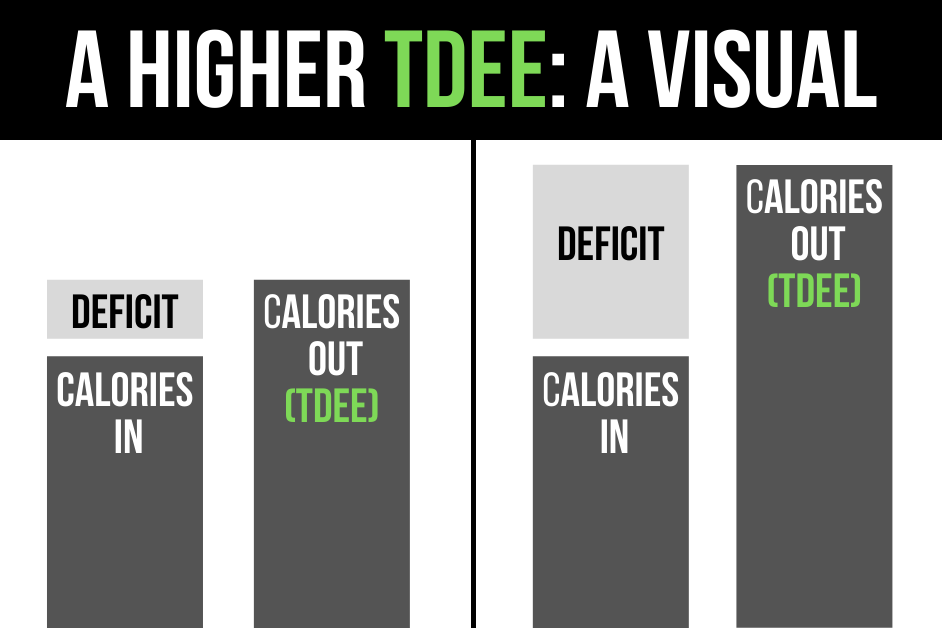
⠀
Notice how much bigger your deficit can be without taking food off your plate or crushing yourself with HIIT ? All you need to do is focus on these nine strategies:
- Eat as much as you can while still losing weight
- Eat .8+ grams of protein per pound of bodyweight
- Eat 25+ grams of fiber per day
- Drink 50+% of your bodyweight in ounces every day
- Walk 6,000-10,000+ steps per day
- Work out no more than 3-4 days per week
- Focus on getting stronger and putting on muscle during those workouts
- Make every effort to manage your stress
- Unplug 30-60+ minutes before bed and consider 11PM a hard cut-off
I know this may seem like a lot at first, so I encourage you to choose 1-2 action steps and nail those before adding anything else to your plan.
My longtime client Carol focused primarily on getting stronger and eating enough protein, and reaped the rewards:
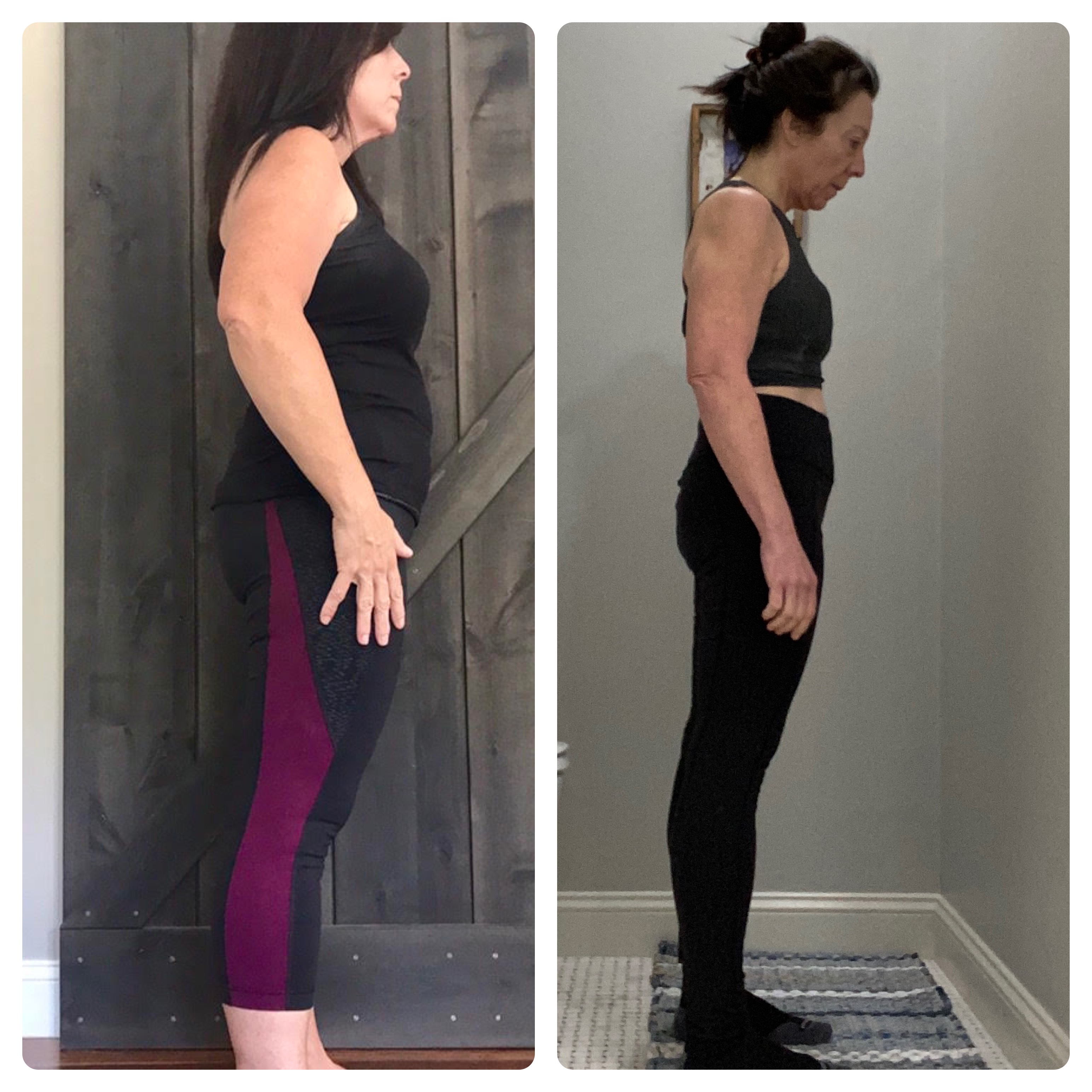
Bri focused primarily on getting her sleep in check, which amplified all her other efforts:
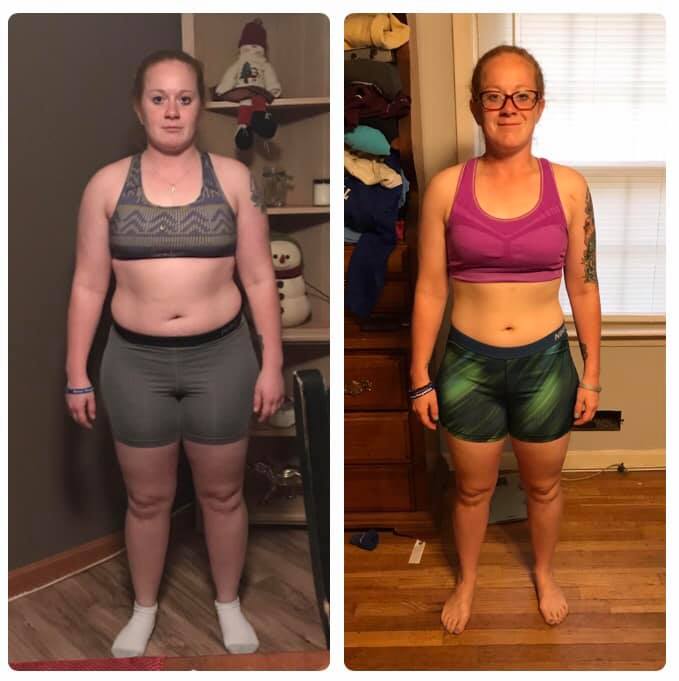
If you’re unsure of where to begin, or want somebody in your corner as you navigate this journey, the VIP Coaching Program may be a good fit for you.
I help my clients get crystal clear on where their time, energy, and effort are best directed.
More importantly, I put their long-term success on a higher pedestal than quick, non-lasting scale change.
If this appeals to you, and you’re ready to boost your metabolism and lose fat once and for all, you can begin your transformation right here.



